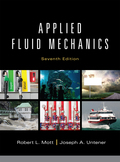
Concept explainers
Determine the velocity of flow and the friction loss as
The velocity of flow
The value of friction loss
Answer to Problem 19.1PP
The velocity of flow, V=570ft/min
The value of friction loss, HL=0.021 in H2O
Explanation of Solution
Given information:
Diameter of the duct, D=18in
Rate of flow, Q=1000 cfm
Length of the duct, L=75 ft
To find out the friction loss, we use the formula
Where,
L= Length of the duct
HL=Friction loss
hL=friction loss of water per 100 ft
friction loss of water per 100 ft is calculated by the chart of friction loss in a duct and it is equal to hL=0.028 in H2O
We compare between any two given values and their intersecting point give the third required value
The velocity of flow is also calculated by the chart of friction loss in a duct and it is equal to
The V=570ft/min
Calculation:
Now we put the known values in equation
HL= 0.021 in H2O
Want to see more full solutions like this?
Chapter 19 Solutions
EBK APPLIED FLUID MECHANICS
- calculate moment of inertia of this tapered beam structurearrow_forwardThe system shown below is in statics equilibrium. Cable OB lies in the xy plane and makes a 30° angle with the positive x-axis. Cable OA lies along the negative y-axis. If the weight of the load being supported is 100 lb, determine the magnitude of the forces in all four cables: OA, OB, OC, and OD.arrow_forwardThis is a mechanics/statics problem involving finding internal reactions, V(x) and M(x). Please refer to image for details. I'm not sure about where to take cuts and how to formulate the equations as a function of x. For my support Reactions I got Ay = 1008.33 lb, By = 1416.67 lb and Cy = 175 lb. and for the first cut V(x) = 1008.33 -250(x) and M(x) = 1008.33x - 125x^2. I'm struggling with the equations for the 2nd and 3rd cut.arrow_forward
- As shown in the figure below, a ring is used to suspend a load and is supported by Cable OA and Spring OB. Given that the tension in Cable OA is 400 N, what is the weight of the load being supported? Assume the system is in static equilibrium.arrow_forward4. (a) State the conditions that must be met to ensure dynamic balance is achieved for long rotors. (b) A rotor carries three out-of-balance discs in planes A, B and C as shown in Figure 4. The out-of- balance mass x radius products of the rotor discs are tabulated in Table 4. The shaft is to be dynamically balanced by adding balancing masses in planes P and Q, spaced along the shaft at a distance da = 800 mm. Determine the magnitude mara and angular position of the balancing mass x radius product that must be added to plane Q. MBB Ов θε mdc Мага End View on Plane P P MBB MATA dA dB dc do Figure 4 moc Table 4 MATA = 0.6 kg mm 6A = 0° d₁ = 200 mm mers = 0.2 kg mm 6g = 45° dB = 400 mm mcrc = 0.4 kg mm Bc=240° dc = 600 mm Ans. (b) = 110.5°, moro = 0.2 kg mmarrow_forwardNeed help in adding demensioning am am so confusedarrow_forward
- Complete the following activity. Save as .pdf and upload to the assignment to the dropbox. 口 Use the general dimensioning symbols to correctly specify the following requirements on the drawing above.arrow_forwardplease solve and show workarrow_forwardWater is boiling in a 25 cm diameter aluminum pan (k=237 W/mK) at 95 degrees C. Heat is transferred steadily to the boiling water in the pan through its .5 cm thick flat bottom at a rate of 800 W. if the inner surface temp of the bottom of the pan is 108 degrees C determine the boiling heat transfer coefficent on the inner surface of the pan and the outer surface temp of the bottom of the pan.arrow_forward
- please solve and show workarrow_forwardplease solve and show workarrow_forwardA thin plastic membrane separates hydrogen from air. The molar concentrations of hydrogen in the membrane at the innner and outer surfaces are determined to be 0.045 and 0.002 kmol/m^3 respectiveley. The binary diffusion coefficent of hydrogen in plastic at the operation temp is 5.3*10^-10 m^2/s. Determine the mass flow rate of hydrogen by diffusion through the membrane under steady conditions if the thickeness of the membrane is 2mm and 0.5 mm.arrow_forward
 Principles of Heat Transfer (Activate Learning wi...Mechanical EngineeringISBN:9781305387102Author:Kreith, Frank; Manglik, Raj M.Publisher:Cengage Learning
Principles of Heat Transfer (Activate Learning wi...Mechanical EngineeringISBN:9781305387102Author:Kreith, Frank; Manglik, Raj M.Publisher:Cengage Learning
